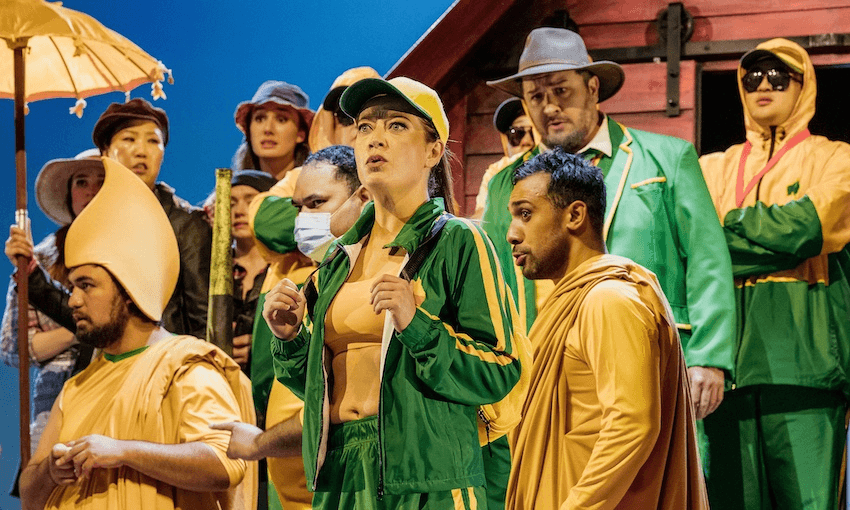The Rossini opera is given a modern New Zealand twist, and manages to stick the landing – mostly.
Musical comedy can be a hard sell. Operatic comedy is even harder, unless it’s one of the more famous ones, or you’re watching the Looney Tunes classic What’s Opera, Doc. Musical comedy doesn’t just need to be funny, it needs to be compelling enough to keep an audience invested beyond the music; operatic comedy needs to give us the spectacle that we expect and desire from an opera on top of that.
Written in the early 19th century by Rossini (better known for The Barber of Seville and Tancredi), Le Comte Ory has a plot that would probably serve as a harrowing drama in modern times, which is where this particular production is set. A chateau in Touraine, France, has been localised to “somewhere in Aotearoa New Zealand, sometime around 2024”. The reigning rugby team of the region are off on tour, leaving their wives and girlfriends behind at a wellness retreat, Chateau Whareora.
In the absence of the rugby team, Count Ory (Manase Latu), the captain of another team, disguises himself as a spiritual guru to give advice to the remaining female locals outside the retreat. Hijinks ensue, and eventually Countess Adele (Emma Pearson) arrives, seeking guidance. Ory’s deception manages to go further than is quite plausible, but it’s opera: plausibility is not the goal here.
It’s a credit to director Simon Philips and his team that Le Comte Ory walks the tightrope as ably as it does. If the story was framed, or performed, even slightly differently, it ends up being a show about a bunch of men wanting to sleep with women who don’t really want to sleep with them, especially by the end of the second act. Thankfully, thanks to some clever staging decisions, and a general sheen of silliness, we never believe that anybody is under any threat, and Ory’s desires seem more clownery than predatory. The second act in particular has some brilliant ensemble staging choices, very much earning the chaos and crowdedness of having over a dozen people onstage much of the time. (The fact that everybody is constantly taking the piss out of Ory is also key to the show’s success.)
Latu and Pearson delight as the leads, the former managing to put over Ory as a lovable horny buffoon rather than a criminal predator and the latter managing her character’s turn from lovelorn idiot to savvy schemetress. Both have stage presence for days; magnetic without drawing attention. Moses Mackay, although sometimes difficult to hear over the orchestra, also has a delightful moment in the second act where he gets to display all of his bravado and charisma.
However, the true highlight is Hanna Hipp in the role of Isolier, here gender-flipped and contemporized to be a queer physiotherapist. Not a single comic moment is missed, and even from the middle of the stalls, she gives a nuanced, deeply funny performance that elevates the otherwise gentle comedy of Le Comte Ory to a 30s-40s-esque screwball level.
The biggest issue that plagues Le Comte Ory is the fact that it’s a comedy. Comedy relies on timing, whether it’s onscreen, onstage or in a book, but given that the opera is in French, the audience relies on surtitles to understand the lyrics. This means that the audience is often not just ahead of the performer and the music, and therefore the jokes, they’re also not in step with each other. In a medium like opera, the lyric, the performer and the music should exist literally in concert with each other. The surtitles end up being their own show entirely; more like commentary than actual text.
The physical and visual comedy in the show is delightful; it’s a shame that we can’t enjoy the lyric and musical comedy as much. It’s a problem that can’t really be solved, given that most of NZ Opera’s audience doesn’t speak French, but it’s a problem nonetheless. (I have less to say of the liberal translation, not being familiar with the original, but it made me chuckle to imagine explaining the concept of emojis to a composer who lived in the 18th century.)
Le Comte Ory isn’t an especially widely-performed opera – this is the first time it’s ever been performed in New Zealand – and it’s not hard to see why. The comedy is gentle rather than laugh out loud funny, and while it’s never unpleasant, the hooks in this production come less from the inherent charms of the text, and more a sumptuous production and an on-point cast working their hardest. There is a little bit of tension given the two “villains” – if you can call Le Comte Ory a serious enough text to have villains – are two men of colour, victimising or intending to victimise a group of women. The casting of both Latu and Mackay, both welcome presences for this company, can’t help but feel a little bit uncomfortable with that context.
Over the past few years, NZ Opera has done a pretty admirable job of dragging the canon into the present. Opera is an artform that is unlikely to die anytime soon, and along with the ballet, it’s one of the few chances that New Zealand audiences get to see inventive, homegrown, spectacle. With Le Comte Ory, the company continues that work, but I’m unsure if the text is necessarily worth dragging into the present. Pleasant, funny, and a chance to see something new – I’ve personally experienced enough Marriages and Barbers for a lifetime – but the effort is perhaps worth more than the story.
Le Comte Ory plays in Wellington on June 13 and 15, then in Christchurch on June 27 and 29.
This review was originally published on the arts and culture newsletter Dramatic Pause.



